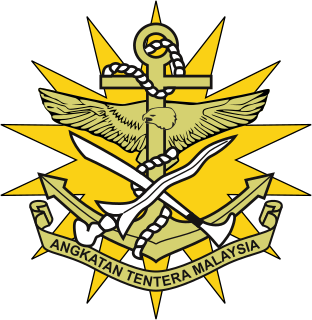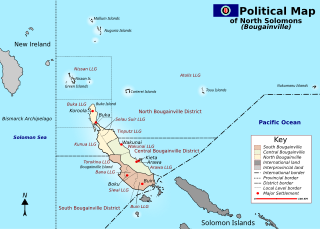
The Armed Forces of the Republic of Armenia, sometimes referred to as the Armenian Army, is the national military of Armenia. It consists of personnel branches under the General Staff of the Armenian Armed Forces, which can be divided into two general branches: the Ground Forces, and the Air Force and Air Defense Forces. Though it was partially formed out of the former Soviet Army forces stationed in the Armenian SSR, the military of Armenia can be traced back to the founding of the First Republic of Armenia in 1918. Being a landlocked country, Armenia has no navy.

The Malaysian Armed Forces, are the armed forces of Malaysia, consists of three branches, the Malaysian Army, Royal Malaysian Navy and the Royal Malaysian Air Force. MAF active personnel is 113,000 and the reservist is 51,600. The Supreme Commander of the Malaysian Armed Forces is the Yang di-Pertuan Agong who is the King of Malaysia.

The Papua New Guinea Defence Force (PNGDF) is the military organisation responsible for the defence of Papua New Guinea. It originated from the Australian Army land forces of the territory of Papua New Guinea before independence, coming into being in January 1973 and having its antecedents in the Pacific Islands Regiment. The PNGDF is a small force, numbering around 2,500 personnel, and consists of a Land Element, an Air Element and a Maritime Element. It is a joint force tasked with defending Papua New Guinea and its territories against external attack, as well as having secondary functions including national-building and internal security tasks.

Solomon Islands is a sovereign state in the Melanesia subregion of Oceania in the western Pacific Ocean. This page is about the history of the nation state rather than the broader geographical area of the Solomon Islands archipelago, which covers both Solomon Islands and Bougainville Island, a province of Papua New Guinea. For the history of the archipelago not covered here refer to the former administration of the British Solomon Islands Protectorate, the North Solomon Islands and the History of Bougainville.

His Majesty's Armed Forces (HMAF) is the military of Tonga. It is composed of three operational components and two support elements.

The Turkish Armed Forces are the military forces of the Republic of Turkey. Turkish Armed Forces consist of the General Staff, the Land Forces, the Naval Forces and the Air Forces. The current Chief of the General staff is General Yaşar Güler. The Chief of the General Staff is the Commander of the Armed Forces. In wartime, the Chief of the General Staff acts as the Commander-in-Chief on behalf of the President, who represents the Supreme Military Command of the TAF on behalf of the Grand National Assembly of Turkey. Coordinating the military relations of the TAF with other NATO member states and friendly states is the responsibility of the General Staff.

The Australian Defence Force (ADF) is the military organisation responsible for the defence of the Commonwealth of Australia and its national interests. It consists of the Royal Australian Navy (RAN), Australian Army, Royal Australian Air Force (RAAF) and several "tri-service" units. The ADF has a strength of just over 85,000 full-time personnel and active reservists and is supported by the Department of Defence and several other civilian agencies.

The Timor Leste Defence Force is the military body responsible for the defence of East Timor. The F-FDTL was established in February 2001 and comprises two infantry battalions, small naval and air components and several supporting units.

The Regional Assistance Mission to Solomon Islands (RAMSI), also known as Operation Helpem Fren, Operation Anode and Operation Rata, was created in 2003 in response to a request for international aid by the Governor-General of Solomon Islands. Helpem Fren means "help a friend" in Solomon Islands Pidgin. The mission officially ended on 30 June 2017.

The Collective Security Treaty Organization (CSTO) is an intergovernmental military alliance in Eurasia consisting of six post-Soviet states: Armenia, Belarus, Kazakhstan, Kyrgyzstan, Russia, and Tajikistan. The Collective Security Treaty has its origins in the Soviet Armed Forces, which was replaced in 1992 by the United Armed Forces of the Commonwealth of Independent States, and was then itself replaced by the successor armed forces of the respective independent states.

1st Battalion, Royal Australian Regiment is a regular motorised infantry battalion of the Australian Army. 1 RAR was first formed as the 65th Australian Infantry Battalion of the 34th Brigade (Australia) on Balikpapan in 1945 and since then has been deployed on active service during the Korean War, the Malayan Emergency, the Vietnam War, Unified Task Force in Somalia, East Timor, Iraq War and Afghanistan. Additionally, the battalion has deployed on peacekeeping and other operations to a number of countries including Japan, Rifle Company Butterworth, Timor Leste, Solomon Islands, Tonga and the Philippines. 1 RAR remains one of the Australian Army's most heavily deployed units sending individuals and detachments to domestic, regional and other enduring operations. The battalion is currently based in Coral Lines at Lavarack Barracks, Townsville, Queensland, where it forms part of the 3rd Brigade.

Manasseh Damukana Sogavare is the sixth and current Prime Minister of Solomon Islands, serving since 24 April 2019. He previously held the office in 2000–2001, 2006—2007 and 2014–2017; in all he has served over nine years as prime minister. Before becoming prime minister, Sogavare served in the National Parliament representing East Choiseul since 1997.
The Mutual Defense Treaty between the Republic of the Philippines and the United States of America (MDT) is a treaty that was signed on August 30, 1951, in Washington, DC, between representatives of the Philippines and the United States. The overall accord contains eight articles and dictates for both nations to support each other if an external party attacks the Philippines or the United States.

The Philippines–Australia Status of Visiting Forces Agreement (SOVFA) is a bilateral visiting forces agreement between the governments of the Republic of the Philippines and the Commonwealth of Australia concerning the status of armed forces from each state while in the territory of the other. A visiting forces agreement is a version of a status of forces agreement that only applies to troops temporarily in a country.

The Air Wing of the Armed Forces of Malta is the aerial component of the current Maltese military. The Air Wing has responsibility for the security of Maltese airspace, conducts maritime patrol and Search and Rescue duties, medical evacuation, VIP transport and provides military assistance to other government departments of Malta.

The Bougainville conflict, also known as the Bougainville Civil War, was a multi-layered armed conflict fought from 1988 to 1998 in the North Solomons Province of Papua New Guinea (PNG) between PNG and the secessionist forces of the Bougainville Revolutionary Army (BRA), and between the BRA and other armed groups on Bougainville. The conflict was described by Bougainvillean President John Momis as the largest conflict in Oceania since the end of World War II in 1945, with an estimated 15,000–20,000 Bougainvilleans dead, although lower estimates place the toll at around 1,000–2,000.

Foreign relations exist between Australia and Solomon Islands. Australia has a High Commission in Honiara and Solomon Islands has a High Commission in Canberra. The two countries are members of the Pacific Islands Forum.

The Solomon Islands and China (PRC) established official diplomatic relations in 2019. Prior to this, the Solomon Islands had diplomatic relations with the Republic of China (Taiwan).
The 2021 Solomon Islands unrest was a series of demonstrations and violent riots in Solomon Islands from 24 to 27 November 2021.
















